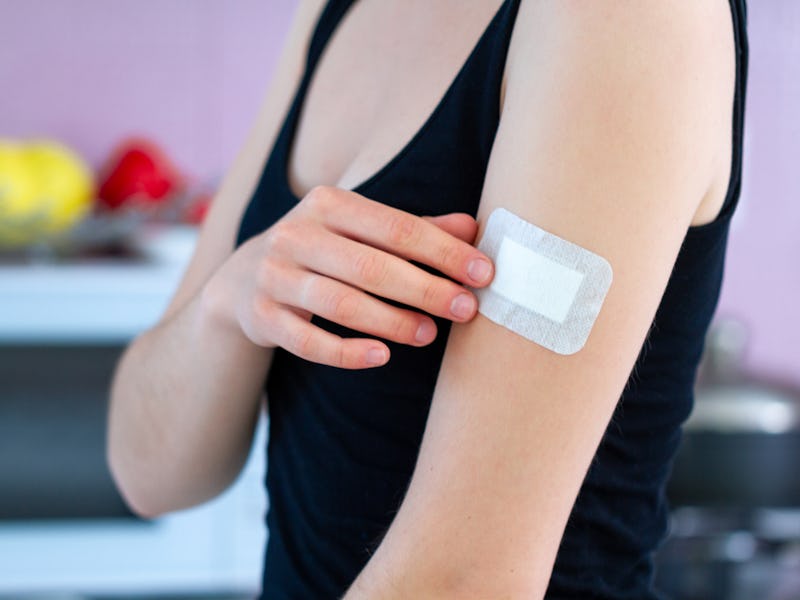Researchers created a 'smart bandage' to heal wounds that won't heal
There are millions of Americans who deal with chronic wounds, and this smart bandage could change their lives.

Chronic wounds affect millions of Americans annually. These wounds include painful ulcers on the foot, leg and beyond. People with diabetes, who have enough on their plate, often suffer from these types of wounds. Treating these wounds properly so they will heal can be difficult, but a new type of "smart bandage" might be able to help solve this problem.
It is estimated nearly 6 million Americans suffer from chronic wounds every year, and treatment costs are roughly $20 billion annually. Those who have diabetes are more likely to suffer from chronic wounds because high glucose levels in the blood can cause poor circulation, which makes it more difficult for a wound to heal. Chronic wounds can also develop after someone has been seriously burned. A wound that takes much longer than normal to heal can become infected and cause more problems—even putting a patient's life at risk.
Researchers at the University of Connecticut have now developed a "smart bandage" that could help chronic wounds heal more effectively. It features miniature needles that are able to deliver medication to a wound wirelessly. The bandage connects to an app, a vast improvement over dumb bandages that connect to nothing. A healthcare professional can program the bandage through the app to make sure it properly treats the patient's wound without the patient having to visit their doctor's office.
This new research was recently published in the journal Advanced Functional Materials. Dr. Ali Tamayol, an assistant professor of mechanical engineering at the University of Nebraska, Lincoln who developed the bandage, said in a statement that this could be a major change in how chronic wounds are treated.
"This is an important step in engineering advanced bandages that can facilitate the healing of hard to treat wounds. The bandage does not need to be changed continuously," Tamayol said.
What's great about this smart bandage is it can treat the wound according to what stage of healing it is in. Every stage of healing requires a different kind of medication to aid the healing process, so this smart bandage can deliver that medication to the wound at the appropriate time without a doctor or the patient having to undress the wound and apply this medication.
Since the needles are quite small, it's not very painful to apply the bandage, and it shouldn't cause any further damage. The bandage was tested on wounded diabetic mice and was shown to be effective for healing their wounds.
Tamayol tells Inverse that each different kind of wound may require different kinds of medication, so the doctor can load the bandage with whatever is right for their patient. He says the small needles help the medicine get past the damaged skin to provide the most benefits.
"We tried to incorporate the miniaturized needles in a way that if there is a crust or a scar on top of the wound, it can get past that or penetrate that and get the therapeutics into the wound bed and the location where healthy cells are located," Tamayol says.
Tamayol says the device can be connected through Wi-Fi or Bluetooth so the doctor can access it remotely. They can then control how much of the medicine is administered and when it is administered.
See also: First lab-grown heart cell transplant could change medicine forever
This isn't the first time this concept has been applied to treating chronic wounds. Back in 2018, engineers at Tufts University developed a prototype for a similar kind of bandage. Sameer Sonkusale, a professor of electrical and computer engineering at Tufts University’s School of Engineering and a co-author of that research, said at the time that this is the next generation of bandages.
"Flexible electronics have made many wearable medical devices possible, but bandages have changed little since the beginnings of medicine," Sonkusale said. "We are simply applying modern technology to an ancient art in the hopes of improving outcomes for an intractable problem.”
That device relied on heating elements to deliver the medication, and Tamayol says his device seems to be more effective than one that relies on heating elements because external heat could cause the device to malfunction. Utilizing miniature needles appears to be the superior option.
Tamayol says his team is now working on testing the smart bandage on larger animals, like pigs, and he has already applied for a provisional patent. He says they will continue to refine the device to make it work as well as possible over the next year or so. He hopes to use it in clinical trials once the time comes.
Abstract
Chronic wounds are one of the most devastating complications of diabetes and are the leading cause of nontraumatic limb amputation. Despite the progress in identifying factors and promising in vitro results for the treatment of chronic wounds, their clinical translation is limited. Given the range of disruptive processes necessary for wound healing, different pharmacological agents are needed at different stages of tissue regeneration. This requires the development of wearable devices that can deliver agents to critical layers of the wound bed in a minimally invasive fashion. Here, for the first time, a programmable platform is engineered that is capable of actively delivering a variety of drugs with independent temporal profiles through miniaturized needles into deeper layers of the wound bed. The delivery of vascular endothelial growth factor (VEGF) through the miniaturized needle arrays demonstrates that, in addition to the selection of suitable therapeutics, the delivery method and their spatial distribution within the wound bed is equally important. Administration of VEGF to chronic dermal wounds of diabetic mice using the programmable platform shows a significant increase in wound closure, re‐epithelialization, angiogenesis, and hair growth when compared to standard topical delivery of therapeutics.